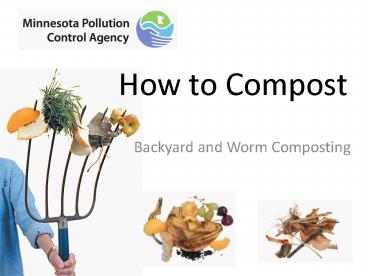Backyard and Worm Composting - PowerPoint PPT Presentation
1 / 14
Title:
Backyard and Worm Composting
Description:
How to Compost Backyard and Worm Composting Why Compost Composting Reduces Greenhouse Gas Emissions. Organic material in landfills creates methane and leachate. – PowerPoint PPT presentation
Number of Views:383
Avg rating:3.0/5.0
Title: Backyard and Worm Composting
1
How to Compost
- Backyard and Worm Composting
2
Why Compost
- Composting Reduces Greenhouse Gas Emissions.
- Organic material in landfills creates methane and
leachate. - Finished compost sequesters carbon and supports
healthy plants. - Composting turns waste products into a valuable
product. - Compost is a beneficial soil amendment that
reduces the need for fertilizers and pesticides
and uses water more efficiently. - Composting reduces trash volume which can lower
trash hauling fees, reduce air pollution and
reduce wear and tear on roads. - Lots of waste is compostable
- Food scraps accounts for 13.9 of the waste
stream - Yard trimmings accounts for 13.4 of the waste
stream
US EPA Municipal Solid Waste Generation,
Recycling, and Disposal in the United States
Facts and Figures for 2010
3
How to Backyard Compost
- Make or buy a compost bin.
- place in a convenient spot near water
- Throw in kitchen scraps and yard waste.
- Mix it up with a pitchfork or shovel once in
awhile. Add a little water.
4
Composting Ingredients
- Successful compost piles are comprised of two
basic materials - Greens/Nitrogen vegetable scraps, fruit,
coffee grounds, grass clippings, green leaves - Browns/ Carbon Dried Leaves, twigs, straw,
sawdust - Do NOT Include Meat, Dairy, Weeds that have gone
to seed, pet wastes, fried or fatty foods
Greens
Browns
5
Compost Pile Maintenance
- Nature will ensures composting will happen
- Turn the pile periodically (add oxygen)
- Water the pile periodically
- Screen material for finished compost
- Use compost in your garden on with your potted
plants
6
Tips for Successful Backyard Composting
- Dont stress its hard to do wrong
- Find ways to make it convenient
- Use a kitchen bucket
- Place your outdoor bin where you can access it
easily - If things are going slow add water and aerate
- Keep some extra leaves around
- browns can be hard to find in the summer
- Leaves can reduce odors and pests
- Expect a few insects
7
Worm Composting
- Ideal for composting indoors
- Great for apartment dwellers
8
Getting started
- Make your own bin
- Use two bins that will nest together
- Drill holes inside the interior bin
- Drill air holes in the lid and along the side of
the container - Use a container 8 inches x 16 inches
9
Bedding Food Scraps
- Common bedding materials are peat moss, shredded
paper or newspaper, and leaves. - For every half pound of food you need one pound
of worms (per week) - Acceptable materials include uncooked fruit,
grains or vegetables - Avoid Meat, Dairy, Egg Shells, Pet Waste, Greasy
or Fried Foods
10
Acquiring and Caring for Worms
- Use Red Wiggler Worms Only
- Available online for 15-25
- Also sometimes available from friendly neighbors
who already compost with worms - 1 Pound of Worms can handle ½ pound of food waste
per week. - Over time more food can be added and worm
population will grow - Keep in area where the temperature is between 50
and 75 degrees F. - Ideal spots are under kitchen sink, in closet or
basement. - Add food waste once or twice per week to
minimally disrupt the worms.
www.wormwoman.com www.redwigglerworms.com www.wo
rkingworms.com www.gardenworms.com
Worm Websites
11
Recovering your Compost
- Harvest worm castings every 6 months or so
- Shift everything to one side of the bin
- Place new bedding on other side
- Add food only to side with new bedding
- After about 2 weeks worms will migrate to new
side - Collect castings from old side and add bedding
- Liquid worm juice --will collect in the
bottom bin
12
Using your compost and worm juice
- Castings can be used for indoor or outdoor
plants. - Castings have high nutrient levels. Use one
handful of castings to 10 handfuls of regular
soil. - Worm Juice is a strong fertilizer for
indoor/outdoor plans - Dilute 201 prior to use
13
Resources
- www.reduce.org
- Minnesota Pollution Control Agency website
- http//www.pca.state.mn.us search Resource
Center Fact Sheets
14
Thank You
- Tim Farnan
- Minnesota Pollution Control Agency
- 651.757.2348
- timothy.farnan_at_state.mn.us































